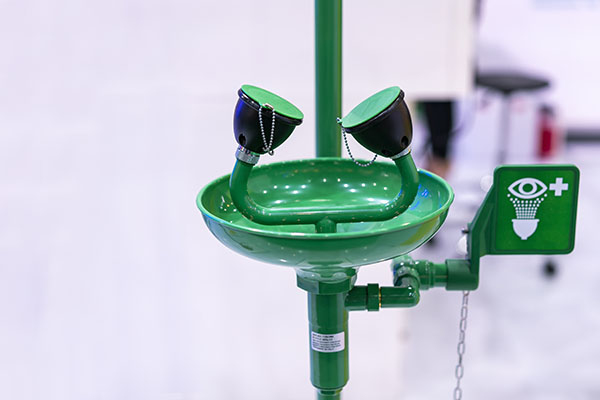

5 Safety Eyewash Station Myths Debunked
By Grainger Editorial Staff 6/22/22
Understand what makes an eyewash station OSHA and ANSI compliant by debunking five widespread safety myths. Learn the differences between personal bottles, gravity-fed units and full eyewash systems to help ensure workplace readiness.
How confident are you that your safety eyewash stations are compliant with OSHA eyewash requirements and ANSI standards? Consider these five commonly believed eyewash station myths.
Myth: “An eyewash flushing bottle counts as an OSHA-compliant eyewash.”
Incorrect. According to the ANSI/ISEA American National Standard for Emergency Eyewash and Shower Equipment (ANSI Z358.1-2014), 16-ounce and 32-ounce bottles are considered personal eyewashes. Personal eyewash units provide immediate flushing and can be used as the employee is making his or her way to a compliant emergency flushing station. A compliant eyewash station must be able to flush both eyes simultaneously for 15 continuous minutes, with a minimum flow rate of 0.4 gallons per minute (gpm).
Myth: “There are no specific guidelines for water temperature for an emergency eyewash or shower.”
Incorrect. Guidelines in ANSI/ISEA Z358.1-2014 specify that emergency eyewash and shower units must deliver tepid flushing fluid. Tepid is defined as water between 60 °F and 100 °F (16 °C and 38 °C), which helps support a full 15-minute flush. Water below 60 °F can cause hypothermia and lead to an incomplete rinse. Water above 100 °F may worsen chemical reactions on the skin or in the eyes. Using a thermostatic mixing valve can help maintain a safe and comfortable water temperature to encourage proper flushing.
Myth: “All gravity-fed eyewashes that meet the minimum 0.4 gpm flow rate are ANSI compliant.”
Incorrect. Gravity-fed eyewashes that meet the minimum 0.4 gpm flow rate must also meet the requirement of 15 continuous minutes of uninterrupted flow.
Myth: “Personal eyewash bottles have an indefinite shelf life as long as the seal remains unbroken.”
Incorrect. Personal eyewash bottles are factory sealed. The shelf life for most personal eyewash bottles can be between two and three years from the date of manufacture. The expiration date will normally be printed on the bottle for easy identification.
Myth: “Emergency eyewash and emergency eye/face wash are synonymous terms.”
Incorrect. Emergency eyewash and emergency eye/face wash have two different definitions under the ANSI/ISEA Z358.1-2014 standard based on the rate of flow. The minimum flow requirement for eyewash is 0.4 gpm compared to the minimum flow rate of 3.0 gpm for an eye/face wash. Emergency eyewash is suggested in a work environment where particulate hazards exist. In a work environment where chemical hazards are a concern, an emergency eye/face wash is suggested, because chemicals can be hazardous to both skin and eyes.

PPE in the Workplace
Lanyards vs. SRLs: Understanding Fall Protection Systems
Shock-absorbing lanyards and self-retracting lifelines both protect against falls, but they work differently. Learn how movement, clearance and system design affect each one.
![]() Our Latest KnowHow
Our Latest KnowHow

Are You Using the Best Cleaning Cloth for the Task?
It's easy to get into the habit of using the same basic cloths for most cleaning tasks. Consider these options for better, more efficient ways to trap dirt and dust throughout your facility.
The information contained in this article is intended for general information purposes only and is based on information available as of the initial date of publication. No representation is made that the information or references are complete or remain current. This article is not a substitute for review of current applicable government regulations, industry standards, or other standards specific to your business and/or activities and should not be construed as legal advice or opinion. Readers with specific questions should refer to the applicable standards or consult with an attorney.









